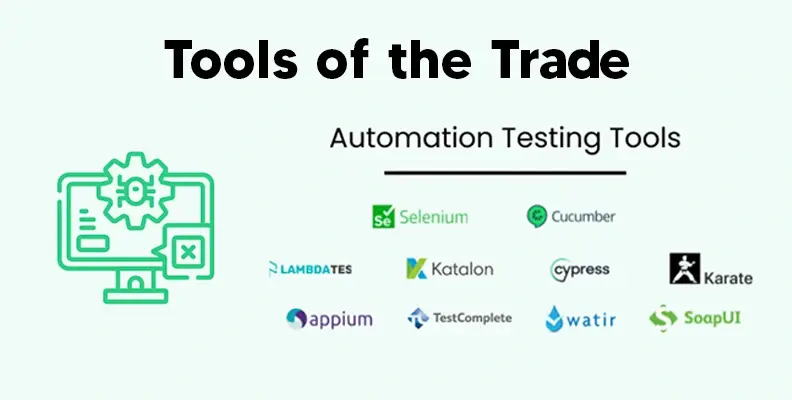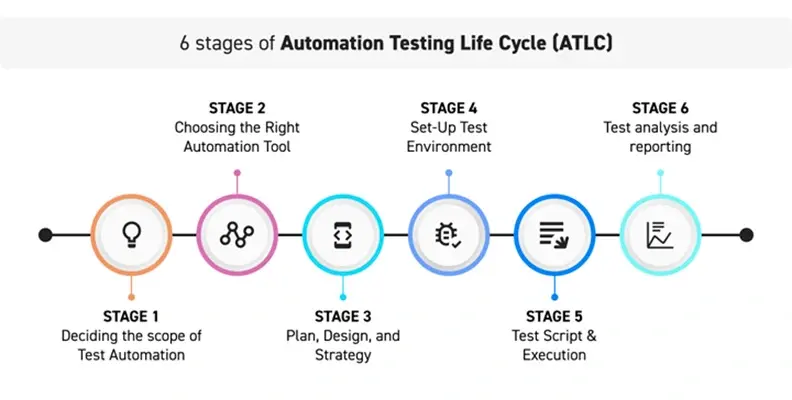Loading.....
Automation Awesomeness- 6 Stages of Software Automation Testing

Welcome to the dynamic realm of automation testing – the unsung hero of software testing!
In this comprehensive blog, we won't merely skim the surface; instead, we'll embark on a journey through the six crucial stages of the automation testing life cycle. Let's explore the heart of automation testing, demystify its processes, and equip you with the knowledge you need. Get set for an exploration that goes beyond the basics, ensuring you're well-versed in every facet of this indispensable testing methodology.
What is Automation Testing?
Automation Testing is a software testing technique that employs specialized tools to execute predefined test cases, comparing actual outcomes with expected results. This process enhances efficiency by reducing manual testing efforts, ensuring faster delivery and improved accuracy. It systematically validates software functionality, identifying defects early in the development cycle.
Automation Testing streamlines repetitive tasks, allowing testers to focus on complex scenarios, and enhancing overall product quality. It is integral in Agile and DevOps environments, fostering continuous integration and delivery. By automating regression tests and functional validations, organizations achieve reliable and consistent results, accelerating the software development lifecycle while maintaining a high level of precision.
Why Use Automation Testing?

The need for automation testing arises from the growing complexity of software projects. It allows for quicker and more efficient testing, especially in scenarios where repetitive tests need to be conducted after every change or addition to the software. Automation testing ensures that the software remains reliable and functions as intended.
Investing time and a bit of money in automation testing is like training your superhero. In the long run, it saves you tons of time and money. You won't need a big team to do tests manually all the time.
Key Aspects of Automation Testing
There are major two key aspects of automation testing, i.e., tools of the trade and different types of testing.
- Tools of the Trade
- Different Types of Testing

Automation testing tools are like the superpowers of our superheroes. They come in various shapes and sizes, each with its own strengths. Some popular tools include Selenium, Appium, and JUnit. These tools help in creating and executing test scripts, making the testing process more efficient.
Automation testing covers various types of testing, such as regression testing, load testing, and integration testing. Each type serves a specific purpose. Regression testing ensures that new changes don't break existing functionalities, load testing checks how the software handles multiple users, and integration testing ensures different parts of the software work well together.
6 Stages of Automation Testing Life Cycle (ATLC)

Automation testing involves creating scripts that specify a set of actions to be performed on the software. These scripts are then executed by automation testing tools. Think of it as giving instructions to a robot – the scripts define the steps the robot (or testing tool) should follow to test different aspects of the software.
Let’s delve into the six crucial stages of the automation testing life cycle, shedding light on each phase's significance and its role in delivering a robust and reliable software product.
Stage 1: Requirement Analysis
The foundation of any successful automation testing endeavour lies in a thorough understanding of the project's requirements. Before embarking on the automation journey, it's imperative to comprehend the functionalities, features, and objectives of the software under test. This initial stage involves collaboration between the testing and development teams to establish a clear understanding of the application's behaviour.
Stage 2: Test Planning
Once the requirements are crystal clear, the next stage involves crafting a comprehensive test plan. This plan outlines the testing strategy, scope, resources, and schedule. Test planning serves as a roadmap for the entire automation testing process, ensuring that all aspects of the application are covered. A well-structured test plan sets the tone for efficient and effective test execution in the subsequent stages.
Stage 3: Test Design
In the test design phase, automation testers create test cases based on the requirements and specifications outlined in the test plan. Test design involves identifying test scenarios, outlining test scripts, and selecting appropriate testing tools. This stage lays the groundwork for the actual implementation of automation scripts, making it a critical step in the overall testing process.
Stage 4: Test Implementation
With the test design in place, the focus shifts to the actual implementation of automation scripts. Testers use chosen automation tools and frameworks to translate test cases into executable scripts. This stage requires attention to detail, as the accuracy and reliability of the scripts directly impact the quality of the testing process. Automation scripts are created to simulate user interactions and validate the application's functionalities.
Stage 5: Execution and Analysis
The execution phase involves running the automation scripts on the application and capturing the results. Testers analyze the outcomes, identify defects, and report them for resolution. Automation testing provides rapid feedback, allowing for quick iterations and improvements. The continuous feedback loop ensures that the software is refined and enhanced throughout the development lifecycle.
Stage 6: Reporting and Maintenance
The final stage revolves around generating comprehensive reports that highlight the testing results, including passed tests, failed tests, and any defects discovered. These reports are valuable for stakeholders, providing insights into the application's health and quality. Additionally, the maintenance phase involves updating and modifying automation scripts as the application evolves, ensuring that the testing process remains aligned with the software's changes.
Conclusion
In the dynamic world of software development, automation testing stands out as a superhero, saving time, ensuring accuracy, and boosting efficiency. With the right tools and strategies, automation testing becomes an invaluable asset for software developers, helping them deliver reliable and high-quality applications.
 Back to blog
Back to blog












